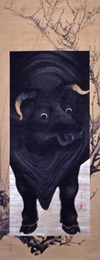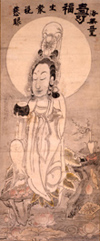1. Archaic Smile | Dogu and Haniwa Figurines
The exhibition begins with dogu figurines from approximately three to four thousand years ago, each graced with a gentle smile. There are various theories about why dogu figurines were created, possibly as childrenfs toys, as images of deities or as protective amulets. And the question remains unanswered, were the gsmilesh on their faces intentional, and or do they just sometimes seem to be smiling at us?
During the latter part of the Kofun period (late 5th to 7th centuries), a new form of figurine, the cylinder-based haniwa figurines, were made in a huge range of forms, depicting people of different professions and social classes, and also dogs, wild boars, horses and deer. Some of these figurines look like they were intentionally given smiles, particularly certain figurines of warriors and farmers. It may have been that the people of the day believed that smiles had the power to protect the tomb they guarded from enemies or evil spirits.
Thus from its earliest days, Japan has seen a continuing succession of images with smiling faces.
2. The Enigmatic Smile | Zen Saints and Genre Images
Kishida Ryuseifs series of portraits of his daughter Reiko were clearly inspired by Leonardo da Vincifs Mona Lisa, images of Kanzan and Jittoku brought to Japan from China, and early ukiyo-e style genre images. This section explores the mystery of Reikofs smile, while also displaying the genigmatic smileh of paintings of beautiful women.
While Kishida Ryusei died at the young age of 38 in 1929, during his lifetime he was popular with patrons and his paintings commanded some of the highest prices of the day. Ryusei was an avid collector of Song and Yuan dynasty Chinese paintings and of early genre paintings from Japanfs pre-modern era. Two legendary monks of Chinafs Tang dynasty, Kanzan and Jittoku (Ch: Hanshan and Shide), were thought to be avatars of the bodhisattvas Fugen (Samantabhadra) and Monju (Manjusri), and they were frequently depicted in paintings in Japan from the Muromachi period onward. Their guncanny and enigmatich smiles are here contrasted with those of Reiko. Ryusei considered the arts of ukiyo|e and genre paintings to have the gdirt of vital living things about them, a somewhat sullied beauty.h This particular aesthetic was then continued by Kainosho Tadaoto, an artist active from the Taisho through Showa eras.
3. Scenes of Laughter
This section begins with fragments of the Yamai no Soshi, or Illness Scrolls, created in the late 12th century and known for their mercilessly humorous depiction of various diseases. The section then continues with otogisoshi short narratives illustrated with simple pictures in a genre that was formed during the Muromachi period.
From Japanfs medieval period through its pre-modern period, the people of the day created richly fertile stories that, while to a degree following Buddhist morals of the day, invariably bring a smile or laugh to their viewers. In particular, their use of artless techniques seems to have the same sensibility as the art works created today that are considered eoutsider artf by the contemporary art world.
This section includes a newly discovered screen version of the popular subject matter Rakuchu Rakugaizu, or Scenes In and Around the Capital. These screens are carefully painted, and yet, somehow exude a fascinating artless naiveteL. These newly discovered screen will surely attract considerable attention in future research on the context of how early Edo period genre paintings inherited and continued the traditions of the earlier otogisoshi forms.
This section also includes works by such Edo period painters as Hanabusa Itcho, Soga Shohaku, and Ikeno Taiga, each work with its own inimitable individuality. At times the artists created seemingly grotesque images, at other times lightly humorous, as each created their own gscenes of laughter.h
4. Animals and Humor
Novel compositional forms, with animals seen face on, animals with human attributes and techniques where animals appear to talk | these are just some of the few unique forms of expression found in Edo period painting.
The adorable puppies drawn by Tawaraya Sotatsu of the early Edo period evoke an involuntary smile from all who see them. The 18th century Kyoto painters whom scholars and art lovers have rediscovered in recent years, including Maruyama Okyo, Ito Jakuchu, Nagasawa Rosetsu, and Mori Sosen, exhibited a gentle approach to their animal subjects and this combined with their superb technical skill to result in humorous animal paintings of the first caliber.
Kamisaka Sekka, an artist active from the Meiji through early Showa eras, took this Edo tradition of humorous animal paintings and developed an all the more graphic form. Similarly Kawanabe Kyosai, trained in Kano school methods and adept at his own particular form of realist depiction, created works that combined elements of the Heian period Choju Giga comic scrolls of animals and Japanese demon paintings to create his own new form of comic images of animals.
5. The Laughter of the Gods
The final section of the exhibition turns to the arts created by the religious figures of the Edo period. These artists did not aim to make their audiences laugh but they used smiles to make their images attractive to the common people. These religious images are joined by the images of the gods of good fortune in whom laughter was ably linked to the joys of good fortune, wealth, and long life.
Hakuin is hailed as the savior of the Rinzai sect during the Edo period, and yet he spent his entire life away from central circles of power, focusing instead on proselytizing amongst the masses from his base at the small Shoinji temple in Hara, Shizuoka prefecture. Hakuin sought to transform the difficult concepts of Zen Buddhism into easily understood maxims, and he created humorous images of readily familiar subjects as his tools. All of these works convey his messages, while also becoming a form of gcomich Zen painting.
Two Buddhist clerics who carved sculpture in wood, Enku and Mokujiki, sought to carve the internalized Buddha spirit from the wood they worked with. They continuously carved a massive number of images as they made long and arduous journeys as part of their stringent religious practices. Many of these images have a magnetic appeal, an engaging smile.
Hakuin and Mokujiki did not begin creating art in earnest until they were over 60 years old, a happy reminder that laughter is something to be enjoyed by people of all ages.

Nagasawa Rosetsu
Ox
c. 1781 - 89
Tessaido
color on paper

Hakuin
Lotus Kannon
Edo Period
ink and color on paper